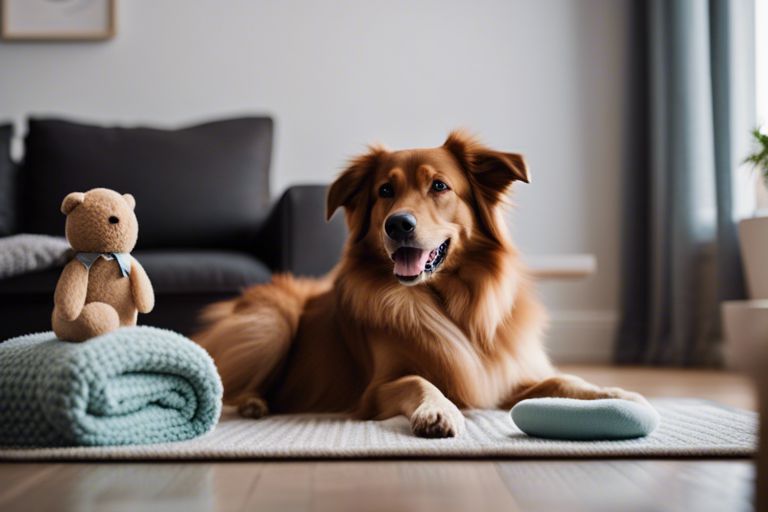Behavioral problems and anxiety are common issues that many dog owners face. It’s important to address these issues promptly to ensure your dog’s well-being and happiness. By understanding the root causes of your dog’s behavior and anxiety, implementing positive reinforcement training techniques, creating a safe and predictable environment, and seeking professional help when needed, you can effectively manage and improve your dog’s behavior. In this blog post, we will discuss some effective ways to handle your dog’s anxiety and behavior issues to help both you and your furry friend live a more harmonious life together.

Identifying Anxiety and Behavior Triggers
Common Anxiety Triggers in Dogs
With dogs being sensitive creatures, it’s vital to be mindful of common anxiety triggers that can cause stress and discomfort for them. Thunderstorms, fireworks, separation from their owners, unfamiliar environments, and loud noises are some typical triggers that can lead to anxiety in dogs. Recognizing these triggers can help you better address and manage your dog’s anxiety.
Recognizing Signs of Behavior Issues
Behavior issues in dogs can manifest in various ways, from excessive barking and destructive chewing to aggression and fearfulness. Recognizing the signs of behavior issues early on is crucial to addressing them effectively. Pay attention to your dog’s body language, such as pinned-back ears, tail tucking, or avoidance behavior, as these could indicate underlying issues that need to be addressed.
For instance, if your dog starts exhibiting destructive behaviors when left alone, it could be a sign of separation anxiety. Understanding the specific triggers and signs of your dog’s behavior issues will enable you to create a tailored plan to help them overcome these challenges.
Strategies for Managing Anxiety
Behavioral Modification Techniques
One effective way to manage your dog’s anxiety is through behavioral modification techniques. These techniques involve changing your dog’s behavior through positive reinforcement and desensitization. By rewarding calm behaviors and gradually exposing your dog to anxiety-inducing stimuli in a controlled way, you can help them learn to cope better with their triggers.
Creating a Calming Environment
For a dog with anxiety, creating a calming environment is crucial. This can include providing a safe and cozy den-like space for your dog to retreat to when they feel anxious. Calming music, pheromone diffusers, and low-intensity lighting can also help to reduce stress and create a soothing atmosphere for your dog.
With creating a calming environment, it’s important to eliminate potential stressors such as loud noises or chaotic environments. By keeping your dog’s living space organized and free from clutter, you can help them feel more secure and relaxed.
Training and Professional Help
When to Consider Professional Training
Keep an eye on your dog’s behavior and if you notice persistent anxiety or behavioral issues such as aggression, fear, or excessive barking, it may be time to consider professional training. Professional trainers can offer customized plans to address your dog’s specific needs and provide guidance on how to effectively train and manage their behavior.
The Role of Veterinary Behaviorists
Help from veterinary behaviorists can be invaluable for dogs with severe anxiety or behavior problems. These professionals are veterinarians who have additional training in behavior and can provide a comprehensive assessment of your dog’s behavior issues. They can offer behavior modification techniques, medication management if needed, and support to help you and your dog navigate through challenging situations.
Behaviorists can work in conjunction with your regular veterinarian to create a holistic treatment plan that takes into account both the physical and emotional well-being of your dog. Seeking help from a veterinary behaviorist can make a significant difference in improving your dog’s quality of life and managing their anxiety and behavior issues effectively.

Supportive Care and Maintenance
Ongoing Management of Anxiety
After addressing your dog’s initial anxiety and behavior issues, it is crucial to maintain a consistent routine to support their ongoing well-being. Regular exercise, mental stimulation, and maintaining a safe and predictable environment can all contribute to managing your dog’s anxiety effectively. Consider incorporating calming activities like puzzle toys, interactive games, and obedience training to help reduce stress and keep your dog engaged.
The Impact of Diet and Exercise on Behavior
To ensure your dog’s overall well-being and behavioral balance, it is important to pay attention to their diet and exercise regimen. A well-balanced diet with high-quality ingredients can positively impact your dog’s energy levels and mood. Regular exercise is also crucial in channeling your dog’s energy and reducing behavioral problems. Consult with your veterinarian to create a tailored diet and exercise plan that suits your dog’s specific needs.
A balanced diet rich in vital nutrients can support your dog’s physical health, mental well-being, and overall behavior. Regular exercise helps in burning excess energy, reducing stress, and promoting positive behavioral traits, such as calmness and obedience. By focusing on diet and exercise, you can significantly contribute to managing your dog’s anxiety and behavior issues in the long term.
Conclusion
Ultimately, understanding the root cause of your dog’s anxiety and behavior issues is crucial in finding effective ways to handle them. Implementing positive reinforcement training, providing mental and physical stimulation, and creating a safe and comfortable environment are key strategies to help your furry friend overcome these challenges. Remember to seek professional guidance if needed and be patient and consistent in your approach. By taking proactive steps and showing your dog love and support, you can help them lead a happier, healthier, and more balanced life.




